Thanks to Space.com and the Tech Media Network for sharing this infographic showing how NASA’s OSIRIS-REx mission will reach out and grab a sample from asteroid RQ26 in 2020. Source SPACE.com:
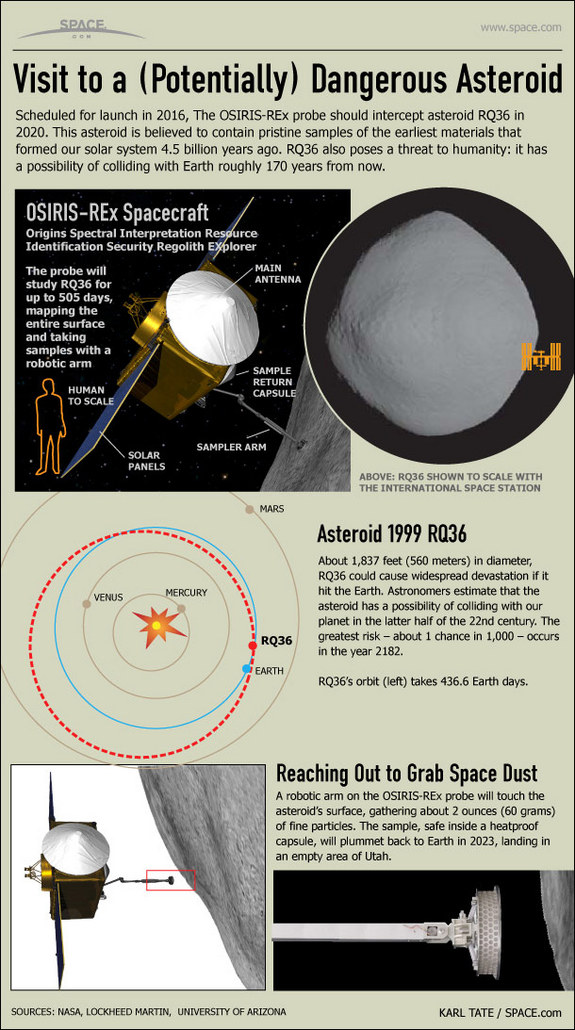
Source SPACE.com.
Thanks to Space.com and the Tech Media Network for sharing this infographic showing how NASA’s OSIRIS-REx mission will reach out and grab a sample from asteroid RQ26 in 2020. Source SPACE.com:

Source SPACE.com.
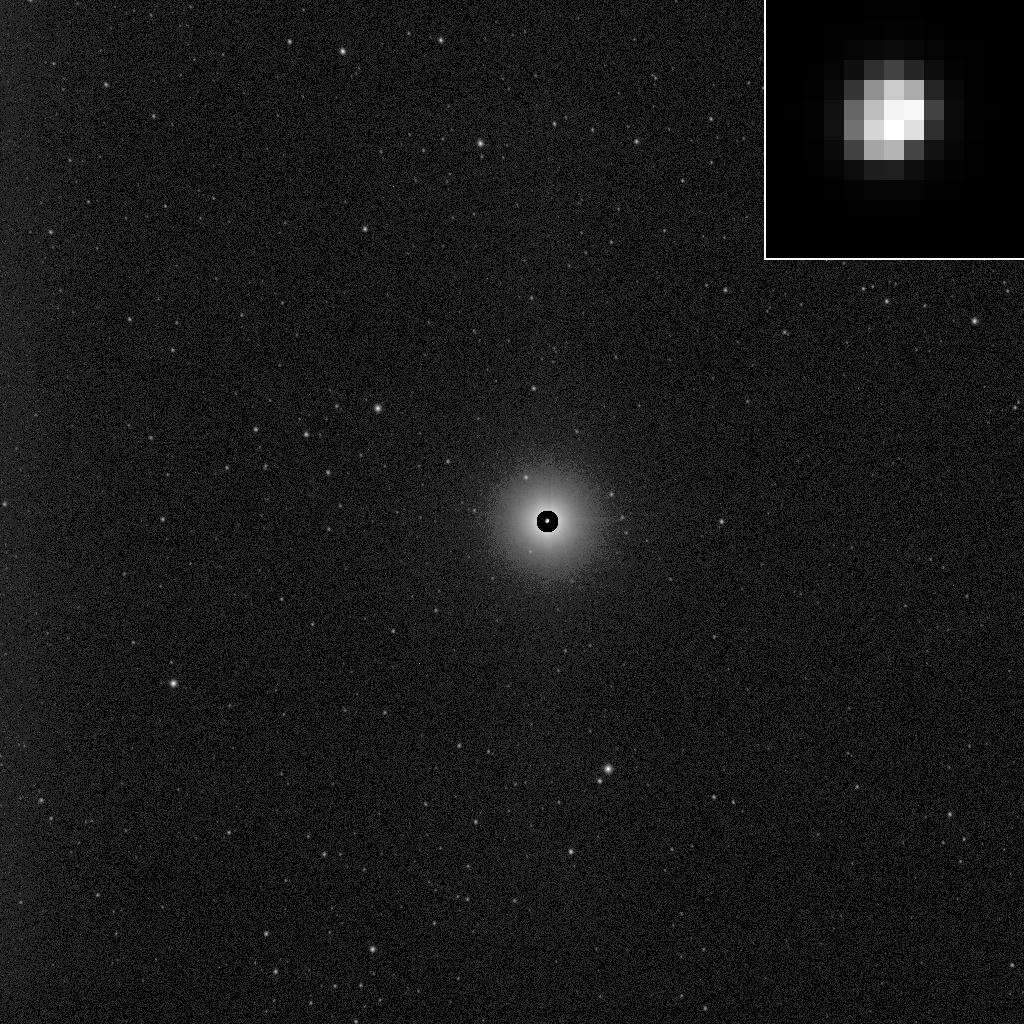
[/caption]
NASA’s revolutionary Dawn Asteroid Orbiter has begun the final approach phase to the giant asteroid Vesta and snapped its first science image. The image was taken on May 3, when Dawn was approximately 1.21 million kilometers (752,000 miles) distant from Vesta using the science imager known as the Framing Camera.
Besides the pure delight of seeing Vesta up close for the first time, the images play a crucial role in navigating Dawn precisely through space and successfully achieve orbit around the protoplanet that nearly formed into a full fledged planet.
Vesta is the second most massive object in the Asteroid Belt and is 530 kilometers (330 miles) in diameter.
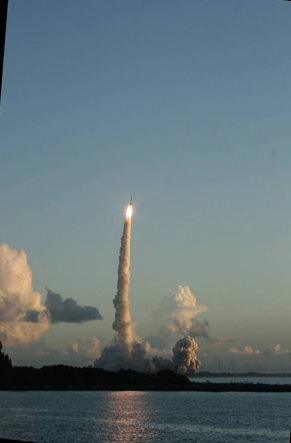
Dawn should be captured into orbit about Vesta around July 16 as the engineering team works to maneuver the spacecraft to match the asteroids path around the sun using the exotic ion thrusters. Using the background stars in the framing camera images, they will be able to determine Dawn’s location in space relative to the stars in order to precisely navigate the spacecrafts trajectory towards Vesta.
“After plying the seas of space for more than a billion miles, the Dawn team finally spotted its target,” said Carol Raymond, Dawn’s deputy principal investigator at NASA’s Jet Propulsion Laboratory in Pasadena, Calif. “This first image hints of detailed portraits to come from Dawn’s upcoming visit.”
The best images of Vesta to date were taken by the Hubble Space Telescope. Jim Adams, Deputy Director of Planetary Science, told me that the images from Dawn’s Framing Camera will exceed those from Hubble in a few weeks.
Dawn will initially enter a highly elliptical polar orbit around Vesta and start collecting science data in August from an altitude of approximately 1,700 miles (2,700 kilometers). The orbit will be lowered in stages to collect high resolution data as Dawn spends about a year collecting data from its three science instruments.
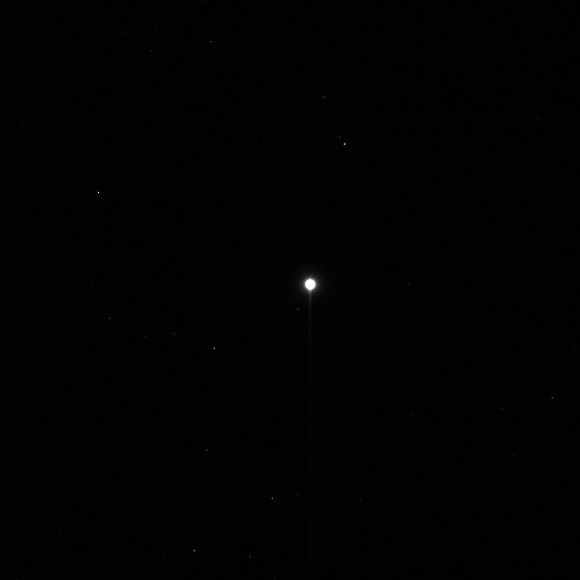
Thereafter Dawn will be targeted to Ceres, the largest object in the Asteroid Belt which it will reach in 2015.
Dawn is an international mission.
The framing cameras have been developed and built under the leadership of the Max Planck Institute for Solar System Research, Katlenburg-Lindau, Germany, with significant contributions by the German Aerospace Center (DLR) Institute of Planetary Research, Berlin, and in coordination with the Institute of Computer and Communication Network Engineering, Braunschweig. The framing camera project is funded by the Max Planck Society, DLR, and NASA.
The Visible and Infrared mapping camera was provided by the Italian Space Agency. The Gamma Ray Detector was supplied by Los Alamos National Labotatory.
Read more about Dawn in my prior story:
Revolutionary Dawn Closing in on Asteroid Vesta with Opened Eyes
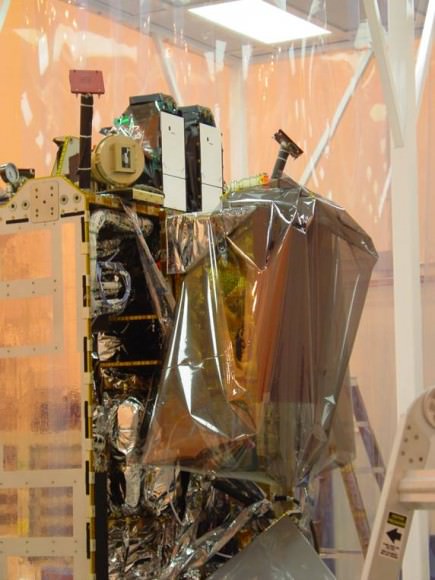
The Earth seems like a safe place, most of the time. But we have evidence of terrible catastrophes in the ancient past, times when almost all life on Earth was wiped out in a geologic instant. What could have caused so much devastation? And will something like this happen again?
Click here to download the episode.
Or subscribe to: astronomycast.com/podcast.xml with your podcatching software.
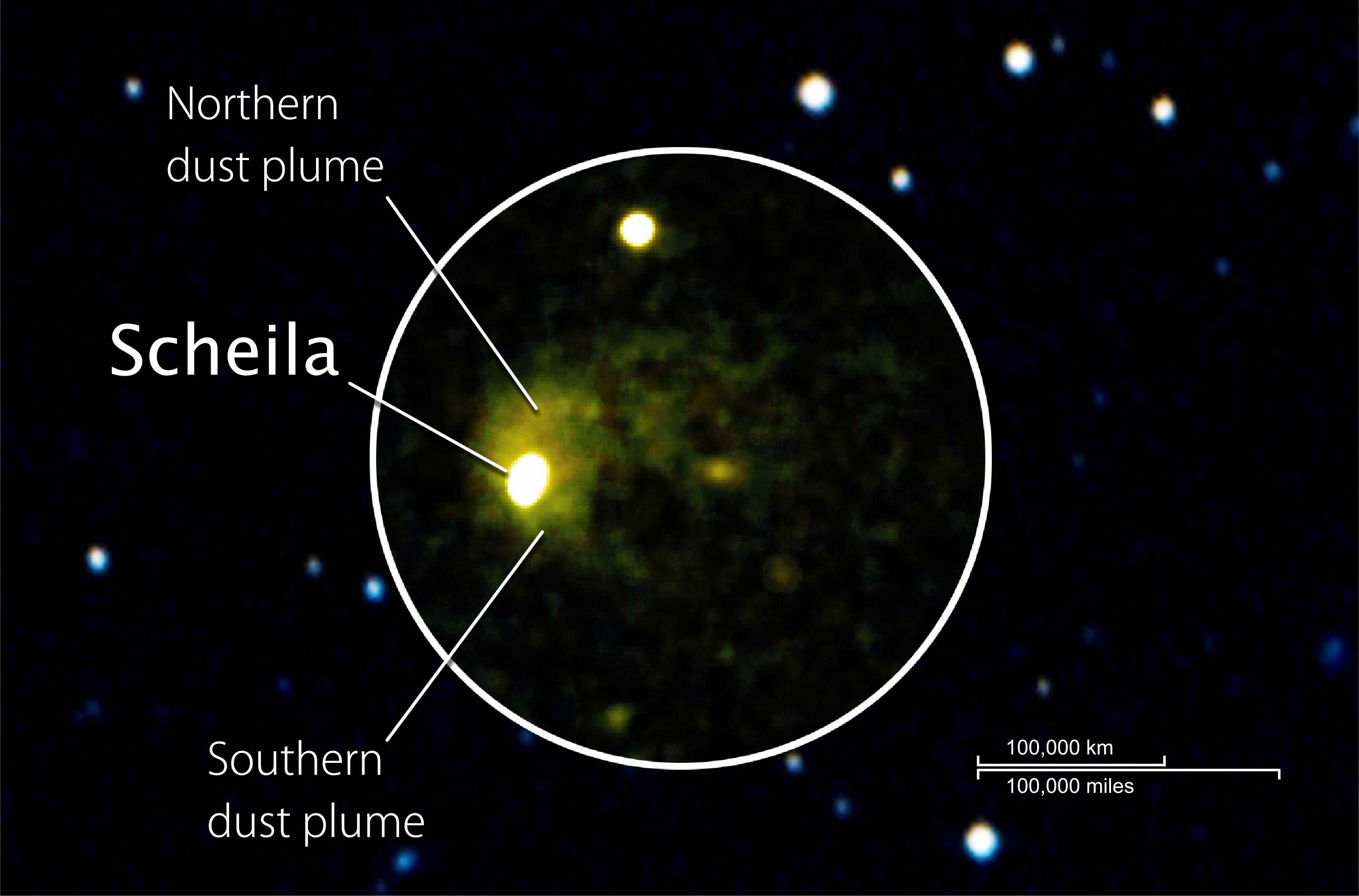
Asteroid or comet? That was the question astronomers were asking after an asteroid named Scheila had unexpectedly brightened, and seemingly sprouted a tail and coma. But follow-up observations by the Swift satellite and the Hubble Space Telescope show that these changes likely occurred after Scheila was struck by a much smaller asteroid.
“Collisions between asteroids create rock fragments, from fine dust to huge boulders, that impact planets and their moons,” said Dennis Bodewits, an astronomer at the University of Maryland in College Park and lead author of the Swift study. “Yet this is the first time we’ve been able to catch one just weeks after the smash-up, long before the evidence fades away.”
[/caption]
On Dec. 11, 2010, images from the University of Arizona’s Catalina Sky Survey, a project of NASA’s Near Earth Object Observations Program, revealed the Scheila to be twice as bright as expected and immersed in a faint comet-like glow. Looking through the survey’s archived images, astronomers inferred the outburst began between Nov. 11 and Dec. 3.
Three days after the outburst was announced, Swift’s Ultraviolet/Optical Telescope (UVOT) captured multiple images and a spectrum of the asteroid. Ultraviolet sunlight breaks up the gas molecules surrounding comets; water, for example, is transformed into hydroxyl (OH) and hydrogen (H). But none of the emissions most commonly identified in comets — such as hydroxyl or cyanogen (CN) — showed up in the UVOT spectrum. The absence of gas around Scheila led the Swift team to reject the idea that Scheila was actually a comet and that exposed ice accounted for the brightening.
Hubble observed the asteroid’s fading dust cloud on Dec. 27, 2010, and Jan. 4, 2011. Images show the asteroid was flanked in the north by a bright dust plume and in the south by a fainter one. The dual plumes formed as small dust particles excavated by the impact were pushed away from the asteroid by sunlight.
The science teams from the two space observatories found the observations were best explained by a collision with a small asteroid impacting Scheila’s surface at an angle of less than 30 degrees, leaving a crater 1,000 feet across. Laboratory experiments show a more direct strike probably wouldn’t have produced two distinct dust plumes. The researchers estimated the crash ejected more than 660,000 tons of dust–equivalent to nearly twice the mass of the Empire State Building.
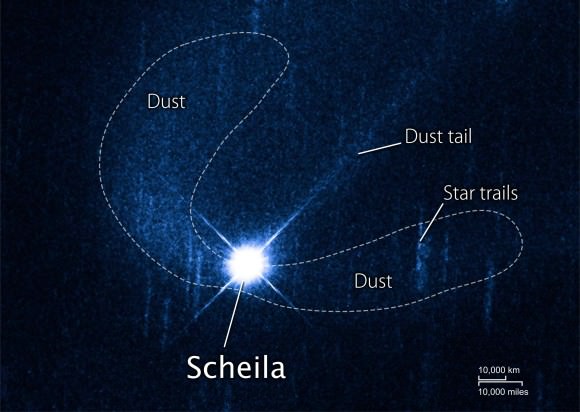
“The Hubble data are most simply explained by the impact, at 11,000 mph, of a previously unknown asteroid about 100 feet in diameter,” said Hubble team leader David Jewitt at the University of California in Los Angeles. Hubble did not see any discrete collision fragments, unlike its 2009 observations of P/2010 A2, the first identified asteroid collision.
Scheila is approximately 113 km (70 miles) across and orbits the sun every five years.
“The dust cloud around Scheila could be 10,000 times as massive as the one ejected from comet 9P/Tempel 1 during NASA’s UMD-led Deep Impact mission,” said co-author Michael Kelley, also at the University of Maryland. “Collisions allow us to peek inside comets and asteroids. Ejecta kicked up by Deep Impact contained lots of ice, and the absence of ice in Scheila’s interior shows that it’s entirely unlike comets.”
The studies will appear in the May 20 edition of The Astrophysical Journal Letters.
Source: NASA Goddard

[/caption]
A large space rock will pass close to Earth on November 8, 2011 and astronomers are anticipating the chance to see asteroid 2005 YU55 close up. Just like meteorites offer a free “sample return” mission from space, this close flyby is akin to sending a spacecraft to fly by an asteroid – just like how the Rosetta mission recently flew by asteroid Lutetia – but this time, no rocket is required. Astronomers are making sure Spaceship Earth will have all available resources trained on 2005 YU55 as it makes its closest approach, and this might be a chance for you to see the asteroid for yourself, as well.
“While near-Earth objects of this size have flown within a lunar distance in the past, we did not have the foreknowledge and technology to take advantage of the opportunity,” said Barbara Wilson, a scientist at JPL. “When it flies past, it should be a great opportunity for science instruments on the ground to get a good look.”
2005 YU55 is about 400 meters [1,300 feet] wide, and closest approach will be about 325,000 kilometers (201,700 miles) from Earth.
“This is the largest space rock we have identified that will come this close until 2028,” said Don Yeomans, manager of NASA’s Near-Earth Object Program Office at JPL, and Yeomans assured that we are in no danger from this asteroid.
“YU55 poses no threat of an Earth collision over, at the very least, the next 100 years,” he said. “During its closest approach, its gravitational effect on the Earth will be so miniscule as to be immeasurable. It will not affect the tides or anything else.”
Astronomers estimate that asteroids the size of YU55 come this close to Earth about every 25 years. We just haven’t had this much advance warning – a testament to the work that Yeomans and his team does at the NEO Program in detecting asteroids and detecting them early.
So, here’s a chance for a close-up look. The 70-meter (230-foot) newly upgraded Goldstone antenna in California, part of NASA’s Deep Space Network, will be imaging the asteroid with radar.
“Using the Goldstone radar operating with the software and hardware upgrades, the resulting images of YU55 could come in with resolution as fine as 4 meters per pixel,” said Benner. “We’re talking about getting down to the kind of surface detail you dream of when you have a spacecraft fly by one of these targets.”
Combining the radar images with ground-based optical and near-infrared observations, astronomers should get a good overview of one of the larger near-Earth objects.
Look for more information in the near future about observing campaigns for amateur astronomers of this object. At first, 2005 YU55 will be too close to the sun and too faint for optical observers. But late in the day (Universal Time) on Nov. 8, and early on Nov. 9, the asteroid could reach about 11th magnitude for several hours before it fades as its distance rapidly increases.
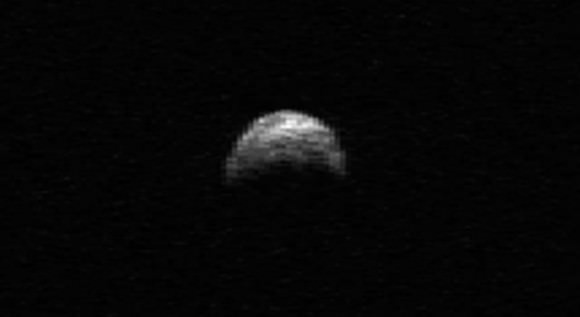
2005 YU55 was discovered in December 2005 by Robert McMillan, head of the NASA-funded Spacewatch Program at the University of Arizona, Tucson. In April 2010, Mike Nolan and colleagues at the Arecibo Observatory in Puerto Rico generated some ghostly images of 2005 YU55 when the asteroid was about 2.3 million kilometers (1.5 million miles) from Earth.
“The best resolution of the radar images was 7.5 meters [25 feet] per pixel,” said JPL radar astronomer Lance Benner. “When 2005 YU55 returns this fall … the asteroid will be seven times closer. We’re expecting some very detailed radar images.”
Radar antennas beam directed microwave signals at their celestial targets — which can be as close as our moon and as far away as the moons of Saturn. These signals bounce off the target, and the resulting “echo” is collected and precisely collated to create radar images, which can be used to reconstruct detailed three-dimensional models of the object. This defines its rotation precisely and gives scientists a good idea of the object’s surface roughness. They can even make out surface features, and astronomers hope to see boulders and craters on the surfaces of 2005 YU55, as well as detailing the mineral composition of the asteroid.
“This is a C-type asteroid, and those are thought to be representative of the primordial materials from which our solar system was formed,” said Wilson. “This flyby will be an excellent opportunity to test how we study, document and quantify which asteroids would be most appropriate for a future human mission.”
Yeomans said this is a great opportunity for scientific discovery. “So stay tuned. This is going to be fun.”
Source: JPL
[/caption]
A newly discovered asteroid could provide one of the best recent viewing opportunities for amateur astronomers, according to the British Astronomical Association. “This is the best NEO close approach these past few years and is bright enough to be observed visually in large (>20cm., or 8-inch) aperture telescopes when on the night of Thursday 14th it will appear as a faint slow-moving star,” writes Richard Miles, the director of the BAA’s Asteroids and Remote Planets Section.
UPDATE: See a new picture of asteroid 2011 GP59 from Ernesto Guido & Giovanni Sostero taken on April 14, 2011, below.
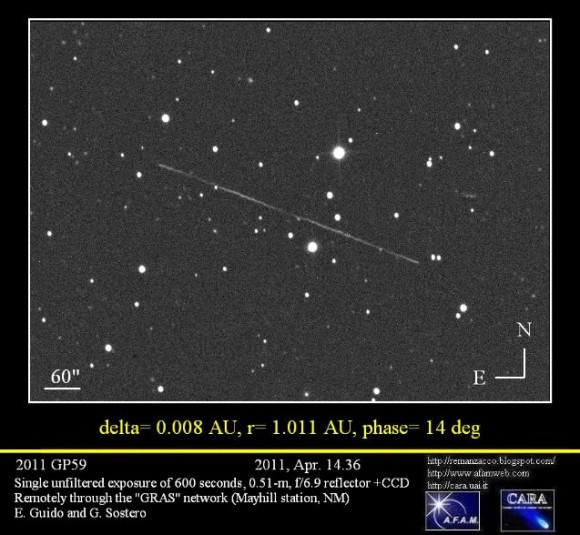
Guido & Sostero sent us a note that they imaged 2011 GP59 early on April 14, remotely from the GRAS Observatory (near Mayhill, New Mexico USA) through a 0.51-m, f/6.9 reflector + CCD.
“It’s a single unfiltered exposure of 600 seconds, showing 2011 GP59 as trail with brightness fluctuations clearly evident,” they said.
(end of 4/14 update)
2011 GP59 was discovered just a few days ago and will make its closest approach to the Earth on April 15 at 19h UT at 1.39 lunar-distances. But it will be brightest at an average magnitude of 13.2 around 00h UT on the night of April 14/15 when Miles says it will be very favorably placed in the sky for observers worldwide.
The asteroid is approximately 60 meters in diameter and appears to be rotating very quickly, about once every 7.35 minutes. Its oblong in shape and rotation will vary the object’s brightness every 4 minutes or so.
Miles reported that David Briggs observing with the Hampshire Astronomy Group’s 0.4-m instrument on the evening of April 11 commented, “This is probably the fastest rotator I’ve seen so far in that it completely disappears from view every 3 to 4 images.”
This object was discovered on the night of April 8/9 by the Observatorio Astronomico de Mallorca (OAM) using a 0.45-m f/2.8 reflector at their La Sagra facilities (J75) in Andalusia, Spain (see http://www.minorplanets.org/OLS/ ). The observers involved were S. Sanchez, J. Nomen, R. Stoss, M. Hurtado, J. A. Jaume and W. K. Y. Yeung.
Brian Skiff of Lowell Observatory has completed a lightcurve analysis which can be found at this link, and positions can be found using the Minor Planet Center’s ephemeris service at this link. You can also find more information on this object from the website of the Remanzacco Observatory in Italy.
The British Astronomical Association is also seeking observations of the Moon on Friday, April 15, between 19:00 and 21:00 UT, when the Aristarchus and Herodotus area of the Moon will match the same illumination, to within +/- 0.5 degrees, as that observed during the famous Transient Lunar Phenomena (TLP) seen by Greenacre and Barr from Flagstaff observatory back on Oct. 30, 1963.
TLPs are very short changes in the brightness of patches on the face of the Moon, which can last anywhere from a few seconds to a few hours and can grow from less than a few to a hundred kilometers in size. This phenomenon has been observed by hundreds of amateur and professional astronomers, but how and why this occurs is not understood. Some astronomers believe that they are the outcome of lunar outgassing, where gas is being released from the surface of the Moon, but most commonly astronomers think it could be an effect from Earth’s own atmosphere.
If you want to help understand TLPs and perhaps observe an event like this for yourself, the BAA Lunar Section is looking for high resolution monochrome, or especially color, images of this area during this time period,, which favors observers in Europe.
But you can check this website from the University of Aberystwyth for many locations around the world of when would be a good time to observe a TLP.
See more information about how to observe a TLP and how to report your observations at the BAA website.
Sources: BAA, BAA (again) University of Aberystwyth
[/caption]
There are plenty of near-Earth asteroids out there, but this latest one studied by two researchers at Armagh Observatory in Northern Ireland is extremely rare in that it has a weird, horseshoe-shaped orbit. Not that Asteroid 2010 SO16 does an about-face and turns around in mid-orbit — no, the asteroid always orbits the Sun in the same direction. But because of its unique orbital path and the gravitational effects from both the Earth and the Sun, it goes through a cycle of catching up with the Earth and falling behind, so that from our perspective here on Earth, its movement relative to both the Sun and the Earth traces a shape like the outline of a horseshoe: it appears to approach, then shift orbit, and go farther away without ever passing Earth.
This asteroid was discovered on September 17, 2010 by the WISE Earth-orbiting observatory.
There are only a handful of other asteroids known to have a horseshoe orbit. But astronomers Apostolos Christou and David Asher say 2010 SO16’s absolute magnitude (H=20.7) makes this the largest object of its type known to-date. It is just a few hundred meters across, so the other asteroids are extremely small, and none of the other horseshoe asteroids have orbits that are likely to survive for more than a few thousand years. But the researchers did computer simulations of SO16’s orbit, which showed it could stay in its orbit for at least 120,000 years, maybe more.
For an asteroid to have such an orbit means it is in almost the same solar orbit as Earth, and both take approximately one year to orbit the Sun.
The Technology Review Blog explained it this way:
“Two points are worth bearing in mind. First, objects further from the Sun than Earth, orbit more slowly. Second, objects that are closer to the Sun orbit more quickly than Earth.
So imagine an asteroid with an orbit around the Sun that is just a little bit smaller than Earth’s. Because it is orbiting more quickly, this asteroid will gradually catch up with Earth.
When it approaches Earth, the larger planet’s gravity will tend to pull the asteroid towards it and away from the Sun. This makes the asteroid orbit more slowly and if the asteroid ends up in a orbit that is slightly bigger than Earth’s, it will orbit the Sun more slowly than Earth and fall behind.
After that, the Earth will catch up with the slower asteroid in the bigger orbit, pulling it back into the small faster orbit and process begins again.
So from the point of view of the Earth, the asteroid has a horseshoe-shaped orbit, constantly moving towards and away from the Earth without ever passing it. (However, from the asteroid’s point of view, it orbits the Sun continuously in the same direction, sometimes more quickly in smaller orbits and sometimes more slowly in bigger orbits.)”
Right now, SO16 is near one of its closest points of approach, chasing the Earth on its inside orbit. It will be tagging along near Earth for the next few decades until it is pulled all the way over into the outside orbit and it slowly recedes from view.
The researchers say the existence of this long-lived horseshoe raises the twin questions of its origin and whether objects in similar orbits are yet to be found. Additionally, they suggest that SO16 may be a suitable test target for the direct detection of the Yarkovsky acceleration as it makes frequent close encounters with the Earth during the next decade.
Paper: “A long-lived horseshoe companion to the Earth”
Sources: Technology Review Blog, Wikipedia
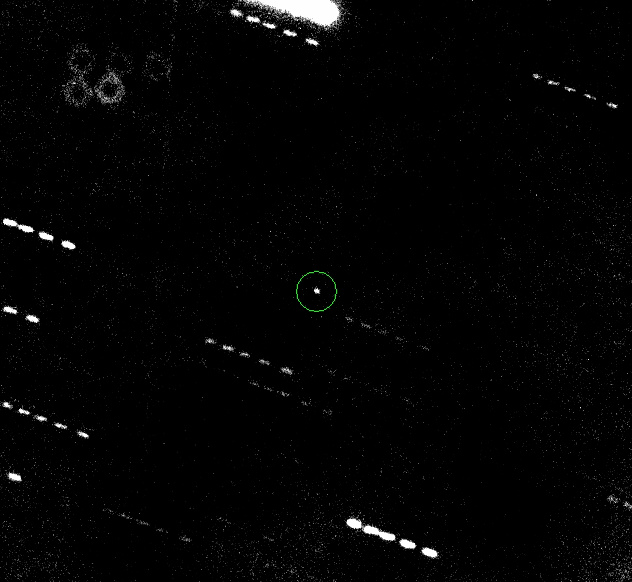
[/caption]
Asteroid Apophis continues to be an object of interest for astronomers. Even though the possibility of an Earth impact by the now-famous asteroid has been ruled out during its upcoming close encounter on April 13, 2029, this close flyby will significantly change Apophis’s orbit, and astronomers are uncertain how that could affect future encounters with our planet. For that reason, astronomers have been eager to obtain new data to further refine the details of the 2029 encounter. However, for three years, the asteroid’s orbit had it “hiding” behind the Sun, but it has now emerged. This newest image of Apophis was taken on January 31, 2011, using the University of Hawaii’s 2.2-meter telescope on Mauna Kea, and astronomers from UH at Manoa say they will make repeated observations of this potentially dangerous near-Earth asteroid.
Astronomers measure the position of an asteroid by comparing with the known positions of stars that appear in the same image as the asteroid. As a result, any tiny error in the catalog of star positions, due for example to the very slow motions of the stars around the center of our Milky Way galaxy, can affect the measurement of the position of the asteroid.
“We will need to repeat the observation on several different nights using different stars to average out this source of imprecision before we will be able to significantly improve the orbit of Apophis and therefore the details of the 2029 close approach and future impact possibilities,” said astronomer David Tholen, one of the co-discoverers of Apophis, who made the latest observations along with graduate students Marco Micheli and Garrett Elliott.
They obtained the new images when the 270-meter (900-foot) diameter asteroid was less than 44 degrees from the sun and about a million times fainter than the faintest star that the average human eye can see without optical aid.
The astronomers will be taking advantage of Apophis’s position for the next few months, as its elliptical orbit around the Sun will take it back into the sun’s glare this summer, making observations – and measurements of its position – impossible. However, in 2012, Apophis will again become observable for approximately nine months. In 2013, the asteroid will pass close enough to Earth for ultraprecise radar signals to be bounced off its surface.
“Radar observations are important because we can estimate orbital parameters and provides us lots of information about an asteroid’s surface features and internal structure, and how they may have formed,” said Lance Benner, an astronomer at JPL, who specializes in radar imaging of near-Earth asteroids. “We need to know these things if we are going to deflect one of these.” Speaking at the American Geophysical Union conference in 2009, Benner said radar is the most powerful astronomical technique for both finding new asteroids and measuring their orbits.
“We can measure their velocity to less than 1mm per second, and do this up to 20 million kilometers from earth. Radar helps us compute the trajectory much farther into the future – even up to 300 years, giving us much more advance notice.” Benner said they can routinely image asteroids at 7.5 meters per pixel, and a new system at the Goldstone radar facility will be able to get the resolution down to 1 meter per pixel.
On April 13, 2029, Apophis will come closer to Earth than the geosynchronous communications satellites that orbit Earth at an altitude of about 36,000 km (22,000 miles). Astronomers say Apophis will then be briefly visible to the naked eye as a fast-moving starlike object.
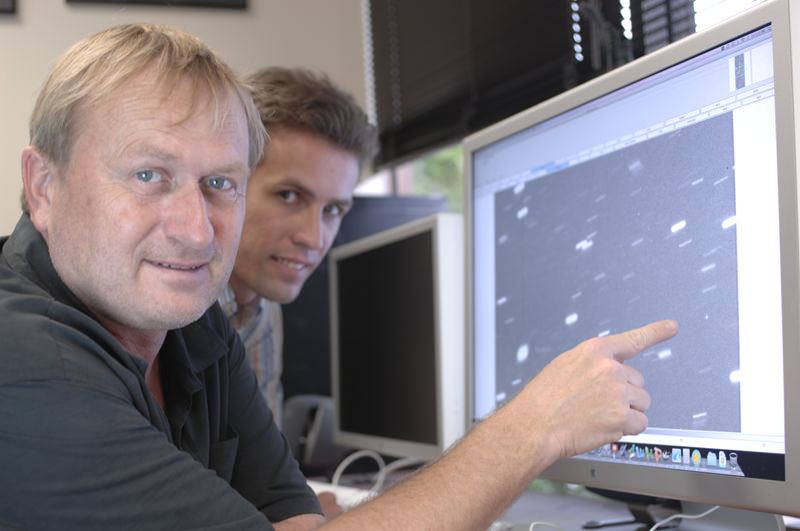
[/caption]
From a University of Hawaii Institute for Astronomy press release:
The Pan-STARRS PS1 telescope on Haleakala, Maui, discovered 19 near-Earth asteroids on the night of January 29, the most asteroids discovered by one telescope on a single night.
“This record number of discoveries shows that PS1 is the world’s most powerful telescope for this kind of study,” said Nick Kaiser, head of the Pan-STARRS project. “NASA and the U.S. Air Force Research Laboratory’s support of this project illustrates how seriously they are taking the threat from near-Earth asteroids.”
Pan-STARRS software engineer Larry Denneau spent that Saturday night in his University of Hawaii at Manoa office in Honolulu processing the PS1 data as it was transmitted from the telescope over the Internet. During the night and into the next afternoon, he and others came up with 30 possible new near-Earth asteroids.
Asteroids are discovered because they appear to move against the background of stars. To confirm asteroid discoveries, scientists must carefully re-observe them several times within 12-72 hours to define their orbits, otherwise they are likely to be “lost.”
Denneau and colleagues quickly sent their discoveries to the Minor Planet Center in Cambridge, Mass., which collects and disseminates data about asteroids and comets, so that other astronomers can re-observe the objects.
“Usually there are several mainland observatories that would help us confirm our discoveries, but widespread snowstorms there closed down many of them, so we had to scramble to confirm many of the discoveries ourselves,” noted Institute for Astronomy astronomer Richard Wainscoat.
Wainscoat, astronomer David Tholen, and graduate student Marco Micheli spent the next three nights searching for the asteroids using telescopes at Mauna Kea Observatories, Hawaii.
On Sunday night, they confirmed that two of the asteroids were near-Earth asteroids before snow on Mauna Kea forced the telescopes to close. On Monday night, they confirmed nine more before fog set in.
On Tuesday night, they searched for four, but found only one. After Tuesday, the remaining unconfirmed near-Earth asteroids had moved too far to be found again.
Telescopes in Arizona, Illinois, Italy, Japan, Kansas, New Mexico, and the United Kingdom, and the Faulkes Telescope on Haleakala also helped to confirm seven of the discoveries.
Two of the asteroids, it turns out, have orbits that come extremely close to Earth’s. There is no immediate danger, but a collision in the next century or so, while unlikely, cannot yet be ruled out. Astronomers will be paying close attention to these objects.
If you felt a sudden breeze at about 19:40 GMT (2:40 pm EST), it was probably from a small asteroid that came extremely close to the Earth today (Feb. 4, 2011). The object, officially designated 2011 CQ1, is fairly small — about 2-3 meters (6.5 -10 ft) wide — and at closest approach it came within 11,855 km (7,366 miles) or about 0.03 lunar distances (LD), or 0.00008 astronomical units (AU). Yep, that’s pretty close.
Richard Kowalski with the Catalina Sky Survey discovered this object early today. The image above is from Giovanni Sostero & Ernesto Guido who made remote follow-up observations to confirm with the Tzec Maun Observatory in New Mexico.
There was no chance this object was going to hit Earth, but it did come well within what is known as the Clarke Belt among geosynchronous satellites.
Find out more about the path this object is taking at Remanzacco Observatory in Italy.
Info on the Minor Planet Center website about 2011 CQ1.
Astronomer Bill Gray calculated a transit line plot showing the path over South America. You can see the charts here:
http://www.projectpluto.com/cq1.png
http://www.projectpluto.com/cq1a.png
And if you are an astrophotographer, let us know if you capture any images of 2011 CQ1.